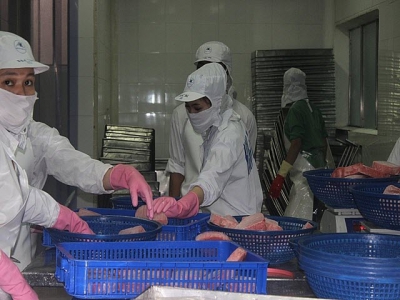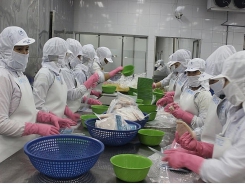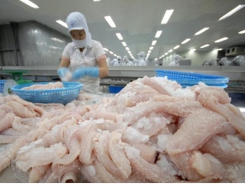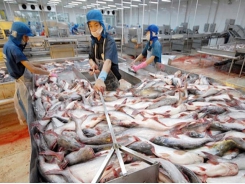Seafood enterprises look to export opportunities from EVFTA

Right after the signing of the EVFTA, many fishery enterprises can gain profits from a deep tax reduction. This also provides great opportunities for seafood enterprises to promote exports after the pandemic.
Seafood exports gain profits right after the EVFTA comes into effect. Photo: TH
More than 840 tax lines are reduced to 0%
According to the Vietnam Association of Seafood Exporters and Producers, along with the old generationFTAs, joining new FTAs such as the EVFTA brings many opportunities for export sectors such as fisheries, especially opportunities from import and export tariffs.
Moreover, right after the EVFTAcomes into effect, there will be nearly 50% of the tax lines with the base tax rate of 0-22%, of which the high tax rate is from 6% to 22%, will be reduced to 0% (approximately 840 tariff lines). The 50% with the base tax rate of 5.5-26% will be decreased by 0% after three to seven years. Particularly, for canned tuna and fish from Vietnam, EU set tariff quotas of 11,500 tons and 500 tons, respectively.
In detail, some processed products with high basic tax rates (20%) will be reduced immediately to 0% such as oysters, scallops, squid, octopus, clams, oysters, processed abalone.
In addition, most frozen squid and octopus products with basic tax rates of 6-8% will be reduced immediately to 0%, while other products such as surimi will be reduced from 14.2% to 0%, and swordfish from 7.5% to 0%.
In addition, frozen shrimp and tiger shrimp (HS code 03061792) are reduced from the basic rate of 20% to 0% right after the agreement comes into effect. Other shrimp products follow the schedule from 3-5 years, processed shrimphas a seven-year tax reduction schedule. Catfish products havea three-year tax reduction roadmap, but smoked fish must wait for seven years to reach the 0% tax reduction.
Frozen tuna products benefit the tax reduction of 0% right way; except for frozen tuna loins that need a seven-year roadmap and canned tuna products enjoys a tax rate of 0% with the tariff quota for Vietnam at11,500 tons.
Increase competitiveness for businesses
The EU is the second largest seafood export market of Vietnam, after the US which accounts for 17% -18% of Vietnam's total seafood export value. In particular, shrimp products,pangasius and seafood products accounted for 22%, 11% and 30-35%, respectively.
Besides, for the basic benefits of import and export taxes, joining the new generation FTAs such as the EVFTA, Vietnam's seafood will get the opportunity to expand export markets, increase competitiveness compared to competitors that are not under the agreement like India and Thailand; attract foreign investment, improve production technology and product quality; create motivation to expand the markets, promote bilateralbusiness cooperation; be able to participate in the regional supply chain thanks to the investment shift of multinational corporations; ensure a stable and transparent business environment and institutions (thanks to improved regulations and policies in accordance with FTA provisions).
However, besides the benefits, Vietnam's seafood industry faces a lot of challenges when joining the EVFTA, such as: strictregulations on technical barriers, quality standards, rules of origin, especially new and complicated regulations; meanwhile our products are less competitive in price in comparison with others in FTAs.
According to experts, in order to take advantage of import and export duties as well as other opportunities in joining the EVFTA and other FTAs, and to avoid risks and limit the disadvantages posed by challenges, seafood enterprises need to grasp and apply flexibly and honestly the rules of origin in FTAs(note that the goods must meet the rules of origin specified separately for each FTA).
At the same time, businesses actively seek and develop raw materials not only in the country but from other FTA partners as well. Enterprises need to pay special attention to the implementation and meet regulations and standards on labor and environment, issues related to sustainable development.These are requirements included in the new generation FTA such as the EVFTA.
Enterprises need to strengthen multinational cooperation, focus on links to improve productivity, quality, good control of food safety and hygiene; actively seek cooperation directions with foreign partners, make technology innovation, and participate in global supply chains.
Thanks to WTO accession, along with joining 16 FTAs with other countries (accounting for over 73% of Vietnam's seafood export turnover), of which 11 FTAs have been signed and took effect, accounting for 55% of seafood exports, the export market for Vietnamese enterprises is increasingly open. Especially, seafood enterprises make profits from preferential import and export tariffs and techniques and technology application to improve productivity, quality and value of fishery products.
As a result, the prestige and brand of Vietnamese seafood have been improved and the product has been exported to 160 markets in the world with a strong increase in key export products such as shrimp (US$3.5-4 billion/year), catfish (US$1.8 - 2.2 billion/year), and tuna or octopus at US$1 billion–US$1.2 billion per year.
Có thể bạn quan tâm
Phần mềm

Phối trộn thức ăn chăn nuôi

Pha dung dịch thủy canh

Định mức cho tôm ăn

Phối trộn phân bón NPK

Xác định tỷ lệ tôm sống

Chuyển đổi đơn vị phân bón

Xác định công suất sục khí

Chuyển đổi đơn vị tôm

Tính diện tích nhà kính

Tính thể tích ao hồ



 Seafood enterprises are angry with limitation of raw…
Seafood enterprises are angry with limitation of raw…  Tra fish exports to EU see a sharp…
Tra fish exports to EU see a sharp…